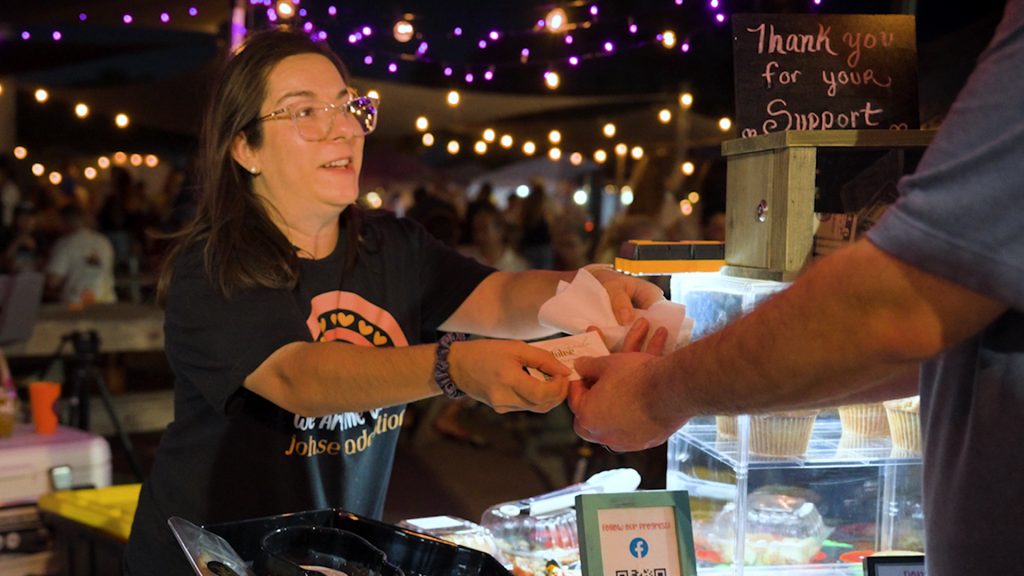Facing $50K in adoption fees, this Texas couple baked up a sweet side hustle

KATY, Texas — Pam and Doug Johse have been on their feet for hours, shuffling between tasks with a Pavlovian urgency spurred by the dings and rings of kitchen timers. Yet as they unload a car packed with the treats they baked earlier today, the Johses find themselves racing against another clock: There’s only 15 minutes until the beginning of the Saturday evening pop-up market where they’ll sell Pam’s famous sourdough banana muffins, chocolate-chunk cookies and Texas-sized cinnamon buns.
They batten their tablecloth against the evening breeze and zip-tie a “Loaves of Love” sign to their tent. Pam fans out the cookies Doug had carefully tucked into plastic bags during their afternoon bake-a-thon. The wind whips. Cookies slip. They readjust.
The stakes at this little pop-up bake shop feel high. Then again, they always do.
The Johses, like one in eight American families, have struggled with infertility. Unlike many other couples, their struggle is permanent — unfixable, according to medical experts.
“August 8, 2023,” Doug says, his voice a whisper, turning to Pam. “I don’t know why I remember that, but that’s the day we found out it would be unsafe for you to have a kid.”
It was the beginning of a journey that has glued them to baking sheets, hand mixers and the steering wheel of their little red SUV as they sell baked goods across their suburban Texas hometown.

“We want to grow our family through adoption,” Doug tells his customers. “But that’s prohibitively expensive. It was either this or get a third job.”
So here they are, slinging baked goods at a pop-up market — a routine weekend activity in recent months — as they work to come up with the $40,000 to $50,000 fee staring them in the face.
Why is adoption such an opaque process?
It took Pam and Doug, both 34, several weeks to adjust to the idea of adopting a child. But once their hearts had settled, they dove into the process of understanding adoption.
That wasn’t easy. The U.S. Census Bureau and other federal agencies track a lot of information about American families: Fertility rates, the number of children and even the age at which mothers have their first kid.
States keep an annual tally of children who have been adopted through state-facilitated foster programs. Independent organizations like the Dave Thomas Foundation issue small surveys. But the university professors, adoption advocates, lawyers and researchers who spoke to Straight Arrow News for this story could not point to a national dataset tracking the cost or quantity of domestic adoptions.
Some of that is by design, says Patricia Taylor, a special projects coordinator at the University of Houston’s College of Social Work, who focuses on adoption.
“I don’t think that those (records) are in a conglomerate state in any place in any of the states,” Taylor tells SAN.
“Once a child is adopted, they become the family member of that family. They’re not counted in any way as different than a child born in the family,” says Taylor, who is an adoptive parent herself. “That’s deliberate.”
But how can a family like the Johses know what to expect when the entire topic is shrouded in secrecy?
‘We’re trying to grow our family through adoption.’
The months of practice Pam and Doug have accumulated shows in their efficiency as they set up their booth. The couple easily outpaces the other vendors nearby. And there are plenty of those: Vintage clothes, sourdough bread, another cookie tent and a coffee cart, to name a few.

This pop-up at No Label Brewing Co., just west of Houston, is one of the more kid-friendly events on the Johses’ circuit. They’re only a few yards from a crayon-blue slide, and enough kids are scrambling around to field a couple of touch football teams.
Kids, of course, love baked goods. And No Label has long been a successful market for the Johses, who today packed their 110-quart cooler with 48 cookies ($4 apiece), 21 muffins ($8 apiece) and 10 cinnamon rolls ($8 apiece).
Their first customers — a man and a woman — approach the Johses’ tent shortly after the market’s 5 p.m. opening, as other booths continue setting up.
“We’re trying to grow our family through adoption,” Doug tells the couple, as he opens a container of cookie samples and offers a taste.
Doug shares his story for the first time in the evening. The woman’s mouth pulls inward from the friendly smile she’d offered a stranger to a tight pout. Her eyes grow big, and she covers her mouth with her hand.
She buys three cookies and two cinnamon rolls, and wishes the Johses good luck.
By 5:45, they’ve sold half the cinnamon rolls, and the slanting sun reveals smudged fingerprints on the display case glass Pam had fastidiously wiped clean during setup, evidence of customers’ excited finger-pointing.
The Johses tidy their table between customers. Doug dances to the Macarena, earning a smile from his wife, who rocks from her heels to her toes — not so much dancing as trying to relieve her plantar fasciitis, which often acts up on market days when she stands for hours straight.
“How are we doing on the cinnamon rolls?” Pam asks Doug around 6:30, as he rifles through the cooler to assess inventory.
“We have two,” he answers. “Unfortunately, because I really want to eat one.”

Pam gives him a look — teasingly stern. “No,” she tells her husband, then turns back toward potential customers. Her back faces Doug, revealing the words “Future Mommy” inked onto her shirt between her shoulder blades.
How much does it cost to adopt a baby in the US?
The revelation that Pam cannot carry a child still sits with the Johses.
“Honestly,” Pam says, “I’m still processing it.”
But in January 2024, the couple sat down to begin their adoption research in earnest.
The beginning of the journey is best described as “an emotional roller coaster,” according to Pam, who earned an advanced degree in Google during her after-work hours, trying to make sense of the framework surrounding adoption.
“We were trying to do everything on our own, do the research on our own,” she says. It didn’t work. There were too many variables in every equation they wrote. Undefined Xes they couldn’t solve for.
“When we were doing our own research, I didn’t fully understand how the process worked,” Doug says. “So I’d set a goal: I was going to reach out this day, and we’re going to do this, and come to find out that’s not the way it’s done.
“Once we realized we were in over our head with the research, we did hire a consultant. I didn’t even know there were adoption consultants, but we met a friend of a friend through church.”
So went the first check — a worthy fee, the Johses say — to pay someone to create a binder that serves as their information headquarters, with lists of costs, inquiries to make and, perhaps most importantly, details about the adoption agency the Johses selected.
The next check will be bigger. They’re not yet fully certain what the total cost will be: Some will depend on the birth mother’s medical and living expenses, which can’t always be predicted in advance. But the Johses have been told to budget at least $40,000 for the one- to two-year process.
That will all kick off in the first quarter of 2026, when they make their first $15,000 deposit and officially enter the pipeline. All of the time leading up to that moment — the research, the consultants, the pre-dawn bake-a-thons and post-dusk tent-breakdowns — is just the prologue.
‘I’m not there yet, but I will be.’
By a little after 7 p.m., there’s a $100 bill tucked into the lockbox atop the muffin case. That happens from time to time — folks who are moved by the Johses’ story want to help in ways that go beyond an $8 muffin. A week earlier, Doug says, someone anonymously donated $1,000. That helps the Johses toward their $15,000 down payment. It also helps them feel less alone in this journey.
“My wife’s adopted,” a man tells Pam a little more than halfway through the four-hour market. It’s the third such revelation the Johses have experienced tonight. They’ve met folks who are adopted, as well as a family that has adopted a child. These customers share their insights and encouragement that, though it’s daunting, the rewards can be equally overwhelming.

That sense of community tempers the disappointment. But the markets can also be hard on their emotions.
During a lull in traffic, Pam leans against her table and watches the crowd. Her eyes snag on a mother dancing with her infant to “Footloose” as it blares over the brewery’s speakers. The mom smiles and swings her baby overhead like a scene from “The Lion King” as the child kicks in delight.
The scent of an open pack of Pampers wipes wafts through the wind, momentarily overpowering the omnipresent tinge of craft beer that typically permeates the brewery’s air. It’s too much. Pam’s eyes stay on the little girl in the sun-yellow romper, even as she reaches for a tissue to dab away the tears threatening to spill over onto her cheeks.
“I’m trying to hold it back, but it’s hard,” Pam confesses.
“I have to keep reminding myself, I’m not there yet, but I will be,” she says. “I will be.”
Why is it so expensive to adopt a child?
The federal government does track one small adoption data point: Every five years, the National Center for Health Statistics asks women ages 18 to 49 whether they have ever tried to adopt. In 2019, 4.7% of women said they had taken steps to adopt a child. But the share who made it to the finish line was much smaller: 1.3%.
So what separates the 3.1 million women who attempt adoption from the 800,000 who sign the paperwork? Time and money are big factors. Adoption Angels, the San Antonio-based agency the Johses are working with, lists the average cost of an agency adoption as $40,000 to $50,000. And once a family signs on, they’re likely to wait between 12 and 24 months.
“Adoption is expensive,” says Sehar Hirani, a Katy-based family attorney.
“We work on a retainer basis,” Hirani tells SAN. “So my hourly rate is $375, right? There’s attorneys that are charging $500 to $700 an hour.” And those hours rack up quickly.
“It’s the length and the amount of paperwork, communication with the court, evaluations, communications with the amicus,” Hirani says. “It adds up.”
She likens the legal fees associated with adoptions to those for divorces. “If you’re not doing it yourself, you’re spending anywhere from $10,000 to $20,000 — same for adoptions.”
Pam and Doug are both civil servants who work for the Harris County Toll Road Authority. In 2023, the couple earned slightly more than $100,000, according to public records.
That’s enough to land them in the middle class. And they take home more each year than the average American parents, who earned $95,154 in 2023, according to U.S. Census Bureau data. So once it comes time to buy strollers, car seats and price out day care — at an average cost of $960 a month, according to the Federal Reserve — Pam and Doug will be just as well equipped to provide for their baby as the “typical” American family.
But also like the typical American family, the Johses don’t exactly have an extra $15,000 lying around. They had to get creative, so they took Pam’s love of baking and joined the ranks of 27% of American adults who earn extra income through a side hustle.
‘I love what y’all are doing here.’
At 8:45, with 15 minutes left before the market’s end, Pam and Doug do another round of inventory. Eleven muffins and about 20 cookies remain. The Johses have made about $260 in sales so far — enough to cover the costs of their market spot and ingredients and bring them closer to their goal.

The booths to the Johses’ left and right have packed up for the night. But Pam and Doug linger. Pam scurries off with a stack of business cards to chat with people sipping beer, enjoying the relatively cool Texas evening. She seeks out customers with purpose: Every muffin sold is a step closer to bringing home a child who will one day stand next to her as she bakes.
At 9 o’clock on the dot, a woman in a blue shirt walks up to the table, where Doug stands alone.
“I love what y’all are doing here,” the woman tells Doug. “I was adopted.”
A small line — full of folks who’ve spoken with Pam on her rounds — forms. The two women behind her bob their heads to “Don’t Stop Believing” playing through the speakers.
But the woman at the front of the line pauses to talk with Doug as she orders three muffins and four cookies. They take their time chatting; the booth is about cookies, yes, but it’s also about connections.
“Good luck,” the woman says after several moments, as she turns to walk away, her hands full of baked goods. “I’ll be praying for you.”
The post Facing $50K in adoption fees, this Texas couple baked up a sweet side hustle appeared first on Straight Arrow News.





